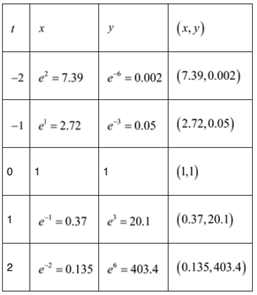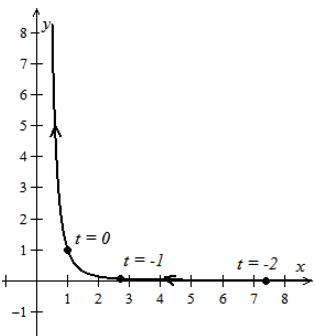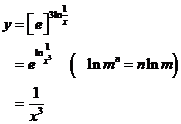
Concept explainers
(a)
To create a table of  and
and  values using
values using
(a)
Explanation of Solution
Given Information:
The given parametric equations are-

Consider the parametric equations given by
 (1)
(1)
The parametric equations are defined for all values of so the domain for
so the domain for is
is Since the exponential function is always positive, both
Since the exponential function is always positive, both and
and  take on positive values only. So take few values of the parameter
take on positive values only. So take few values of the parameter and find corresponding values of
and find corresponding values of and
and Tabulate these results for better appreciation and mark each of the points
Tabulate these results for better appreciation and mark each of the points in the
in the  coordinate plane. Join these points to get the sketch of the given parametric equations. Mark the orientation of the curve as
coordinate plane. Join these points to get the sketch of the given parametric equations. Mark the orientation of the curve as takes on values from negative to positive. The table given below is helpful in plotting the points.
takes on values from negative to positive. The table given below is helpful in plotting the points.

Sketch of the parametric equations is given below. The graph is extending to along both
along both and
and axis. Since for large values of, the exponential function with negative exponent is close to 0, one arm of the graph extends to. And for large value of, the exponential function with positive exponent tends to infinity; the other arm of the graph extends to
axis. Since for large values of, the exponential function with negative exponent is close to 0, one arm of the graph extends to. And for large value of, the exponential function with positive exponent tends to infinity; the other arm of the graph extends to along
along axis. The orientation of the graph is from downwards to upwards for all values of
axis. The orientation of the graph is from downwards to upwards for all values of

To find out the rectangular equation by eliminating the parameter from the two given equations.
from the two given equations.
Explanation of Solution
Given Information:
The given parametric equations are-

Calculation:
From the first of the parametric equations in terms of
in terms of is given by
is given by

Substitute this value of in terms of
in terms of in the second parametric equation to get
in the second parametric equation to get

Therefore, the equation in rectangular coordinates for the given parametric equations is-

Chapter 10 Solutions
EBK PRECALCULUS W/LIMITS
- How to find the radius of convergence for the series in the image below? I'm stuck on how to isolate the x in the interval of convergence.arrow_forwardDetermine the exact signed area between the curve g(x): x-axis on the interval [0,1]. = tan2/5 secx dx andarrow_forwardSet up the partial fraction expansion of the function below. Do not explicitly solve for the variables 5 x²(x − 2)(x − 3)³ (24 - 81)² -arrow_forward
- Draw the triangle and show all the workarrow_forwardsolve these pleasearrow_forwardA factorization A = PDP 1 is not unique. For A= 7 2 -4 1 1 1 5 0 2 1 one factorization is P = D= and P-1 30 = Use this information with D₁ = to find a matrix P₁ such that - -1 -2 0 3 1 - - 1 05 A-P,D,P P1 (Type an integer or simplified fraction for each matrix element.)arrow_forward
- Matrix A is factored in the form PDP 1. Use the Diagonalization Theorem to find the eigenvalues of A and a basis for each eigenspace. 30 -1 - 1 0 -1 400 0 0 1 A= 3 4 3 0 1 3 040 3 1 3 0 0 4 1 0 0 003 -1 0 -1 Select the correct choice below and fill in the answer boxes to complete your choice. (Use a comma to separate vectors as needed.) A basis for the corresponding eigenspace is { A. There is one distinct eigenvalue, λ = B. In ascending order, the two distinct eigenvalues are λ₁ ... = and 2 = Bases for the corresponding eigenspaces are { and ( ), respectively. C. In ascending order, the three distinct eigenvalues are λ₁ = = 12/2 = and 3 = Bases for the corresponding eigenspaces are {}, }, and { respectively.arrow_forwardN Page 0.6. 0.4. 0.2- -0.2- -0.4- -6.6 -5 W 10arrow_forwardDiagonalize the following matrix, if possible. 8 0 6 - 8 Select the correct choice below and, if necessary, fill in the answer box to complete your choice. 8 0 OA. For P= D= 0 3 6 0 B. For P = D= 0 -6 8 0 C. For P = D= 0 - 8 D. The matrix cannot be diagonalized.arrow_forward
 Calculus: Early TranscendentalsCalculusISBN:9781285741550Author:James StewartPublisher:Cengage Learning
Calculus: Early TranscendentalsCalculusISBN:9781285741550Author:James StewartPublisher:Cengage Learning Thomas' Calculus (14th Edition)CalculusISBN:9780134438986Author:Joel R. Hass, Christopher E. Heil, Maurice D. WeirPublisher:PEARSON
Thomas' Calculus (14th Edition)CalculusISBN:9780134438986Author:Joel R. Hass, Christopher E. Heil, Maurice D. WeirPublisher:PEARSON Calculus: Early Transcendentals (3rd Edition)CalculusISBN:9780134763644Author:William L. Briggs, Lyle Cochran, Bernard Gillett, Eric SchulzPublisher:PEARSON
Calculus: Early Transcendentals (3rd Edition)CalculusISBN:9780134763644Author:William L. Briggs, Lyle Cochran, Bernard Gillett, Eric SchulzPublisher:PEARSON Calculus: Early TranscendentalsCalculusISBN:9781319050740Author:Jon Rogawski, Colin Adams, Robert FranzosaPublisher:W. H. Freeman
Calculus: Early TranscendentalsCalculusISBN:9781319050740Author:Jon Rogawski, Colin Adams, Robert FranzosaPublisher:W. H. Freeman
 Calculus: Early Transcendental FunctionsCalculusISBN:9781337552516Author:Ron Larson, Bruce H. EdwardsPublisher:Cengage Learning
Calculus: Early Transcendental FunctionsCalculusISBN:9781337552516Author:Ron Larson, Bruce H. EdwardsPublisher:Cengage Learning





